Speeding up the Design Process with Machine Learning
By Hardik Kabaria, Ehsan Haghighat, Ruiqi Chen, Kyle Kloster, Sai Nelaturi, and Jennifer Kaefer
The many types of resources available determine the ultimate design and performance of a 3D-printed part. With unlimited materials, resources, and time, every possible combination of materials and geometry can be tested to find the one that performs the best. Unfortunately, it would take years to manually design, print, and test all of those possibilities. No one has that kind of time or money.
Carbon set out to create software that could unify the design, development, and manufacturing processes. This software would calculate the mechanical properties of any combination of geometric attributes and test the possibilities without having to print a part. Carbon Design Engine™ software has brought many latticed parts to market, which means it has a lot of data to draw from to create this specialized tool.
How Lattices Work
The design and printing of latticed parts are a considerable advantage of additive manufacturing (AM). The unique properties lattices offer cannot be replicated using traditional manufacturing methods. Some of the advantages of latticed parts include:
- Energy absorption/recovery
- Comfort/stress distribution
- Customization
- Breathability
- Lightweighting
- Spatial zones with variable stiffnesses and mechanical properties
The repeating pattern of any cell type has unique aesthetic and physical properties. For example, the Voronoi pattern has a foam-like nonlinear stress-strain response that results in high energy return and a honeycomb-type aesthetic. In contrast, the Tetrahedral pattern has a buckling response good for comfort cushioning in static conditions, and a triangle aesthetic.
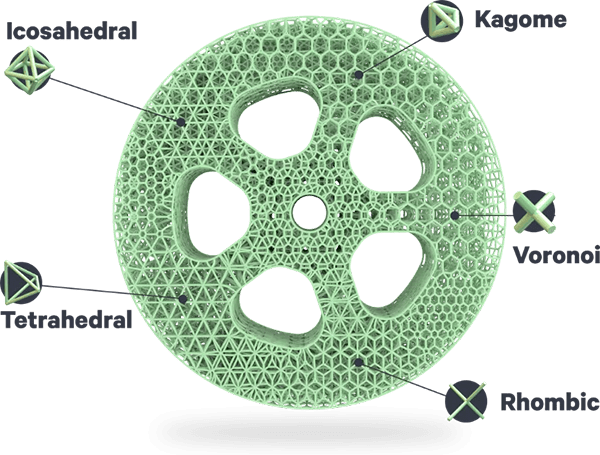
Any of these cell types can be combined to produce zones with different properties within the same part.
Hybrid cells combine two (or more) primary cells into one new cell, producing an infinite, continuously parameterized family of cells.

In a design, these hybrid cells can spatially transition to any other hybrid cell type via a self-consistent interpolation scheme that guarantees strut connectivity. The self-consistent interpolation scheme will estimate values between data points as the cells spatially transition to ensure topological consistency inside the part.
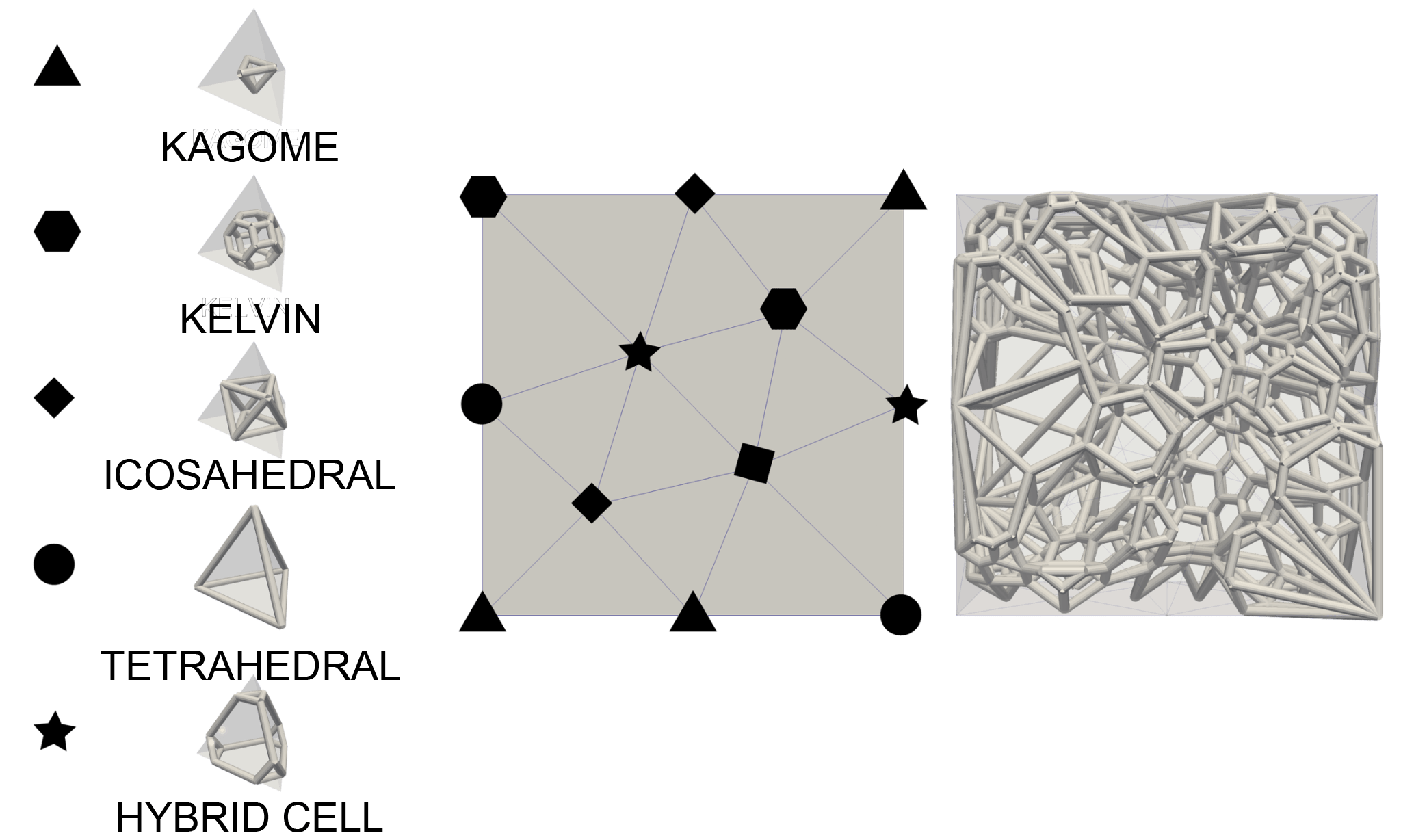
This means that the combinations and possibilities for creating a lattice are endless. How can a designer even begin to find the right combination for their product? Designing, printing, and testing even 100 of these possibilities would take months. While this time is shorter than it would take using a traditional manufacturing process, we can do better. This problem is perfect for simulations and machine learning (ML) to solve.
Simulating the Load on a Lattice
Eliminating the test printing portion of the design process would shorten the time considerably, but narrowing down our choices would save time and simplify the process even more. We set out to add both the ability to simulate validation and use that validation simulation data to narrow down the designer’s choices.
To model such a complex system, we needed a simulator that can accurately model large deformations, buckling, and contact. Among these requirements, handling self-contact is the primary bottleneck for simulators. Dropping these constraints and using a linear solver without contact would result in the computed force-displacement response being unrealistically stiff, and the tool would not be capable of accurately capturing features such as plateau stress and densification stiffness. Recently, researchers from NYU proposed a state-of-the-art automated framework, the Incremental Potential Contact (IPC) algorithm [1], capable of handling very complex multi-body contact physics. IPC provides a penetration-free contact algorithm by introducing mechanistically sound, barrier-energy functionals.
Using IPC, we performed a high-fidelity physics simulation on lattice cuboids. Using one of Carbon’s elastomer materials, we simulated the quasi-static loading of a lattice cell considering both contact and buckling. Then we performed a traditional, physical validation test on a printed part with the same material and compared the simulated validation results with the physical validation results.
Figure 4. Left: Physical test Right: Simulated test
Using this process, we were able to develop a Neural Operator, which uses all this data to predict a lattice puck’s mechanical response using an attention mechanism that processes sequential data and long-range dependencies (like a transformer). We can use automatic differentiation because all the parameters are smooth, including the ones that govern the shape of the lattice. Using physical scaling rules, we were able to generate data for other elastomeric resins. Training and validation continued until we achieved the following validation results shown in Figure X. It only took 210 Finite Element Analysis (FEA) simulations.

Our ML model shows a high correspondence (<3% error) between true and predicted data for the types of lattices we did not specifically train the model on, even significantly different lattice shapes. As an added bonus, our model is 105 times faster than running the simulations again and again.
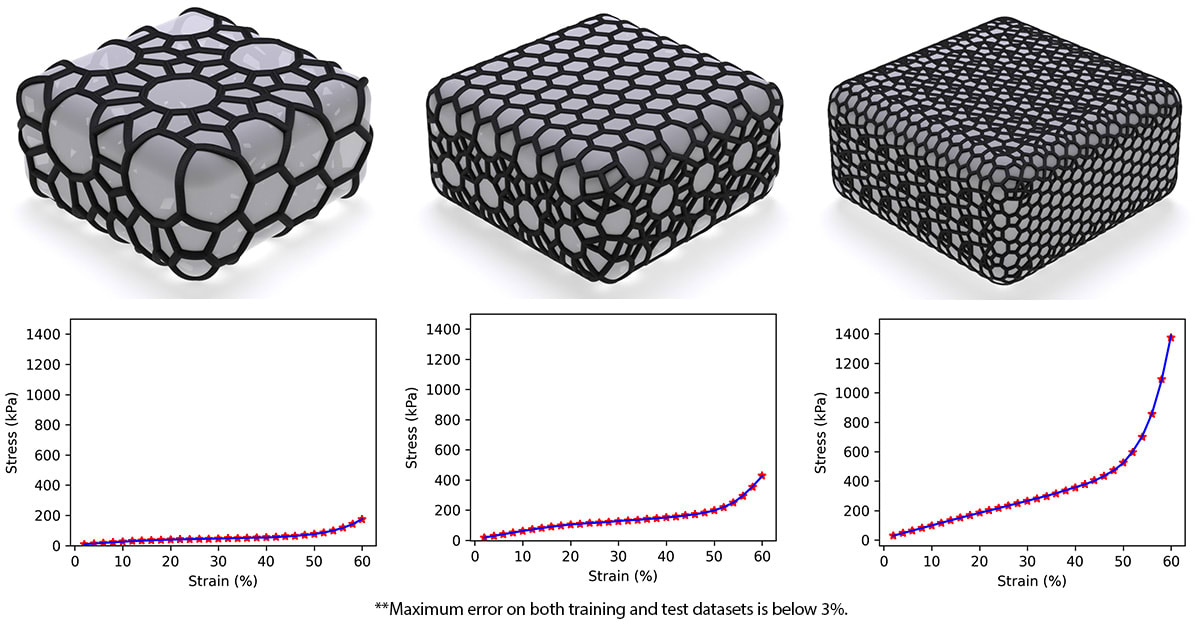
Metamaterials Library in Carbon Design Engine
There are over 9,000 data points in Carbon’s metamaterials library covering a wide variety of mechanical responses, and this is just the tip of the iceberg. Using the “Lattice Search” feature, a designer can define ranges for desired responses, lattice types, and high-level geometric parameters, narrowing the options considerably.
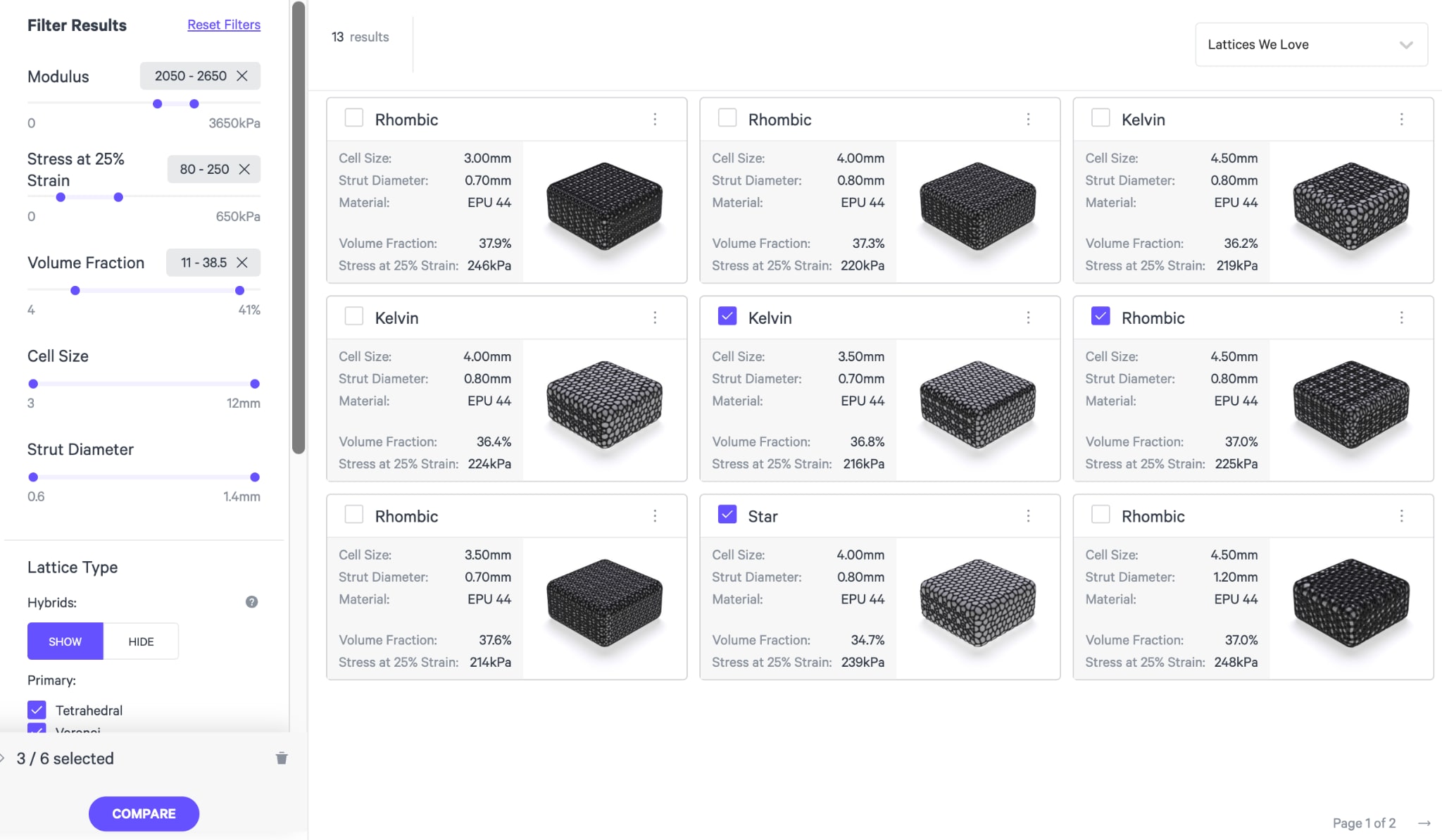
From these options, the designer can compare the non-linear material response up to densification for thousands of lattices. The designer can do all these comparisons without having to simulate each option individually.
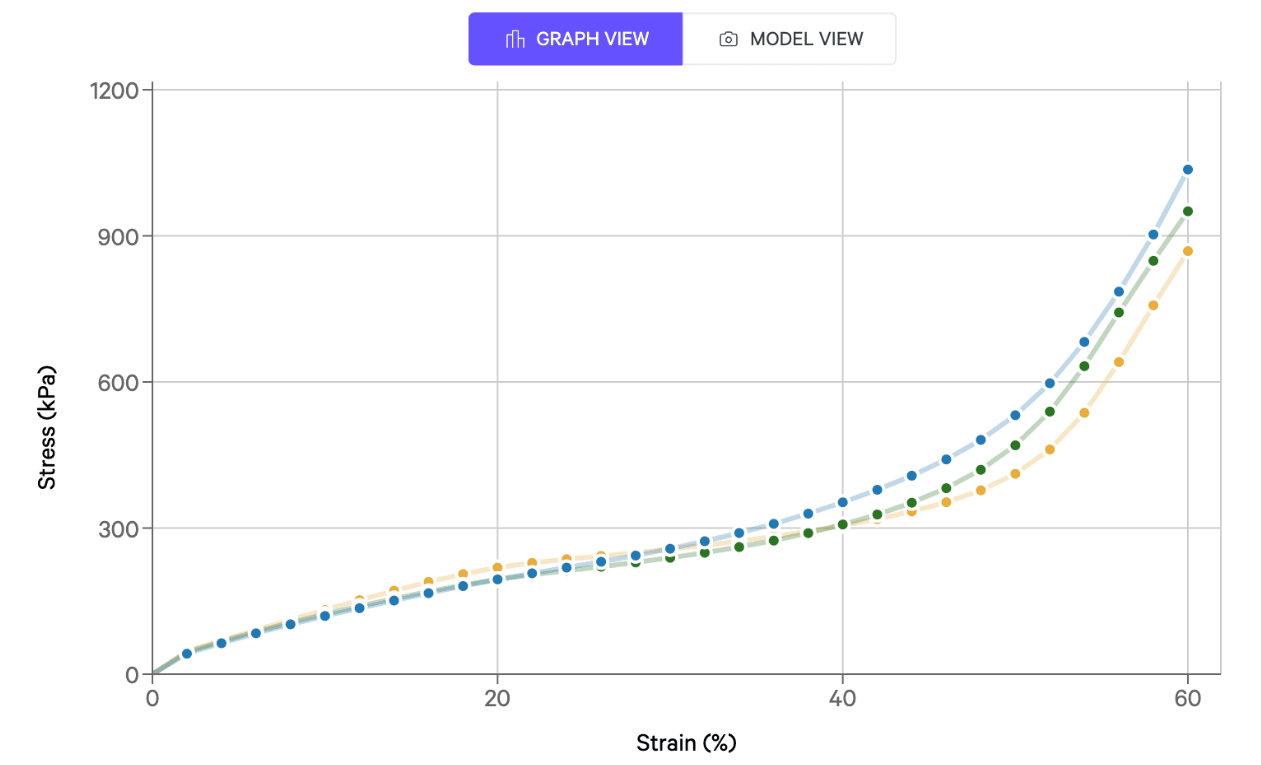
| Lattice Type | Material | Cell Size (mm) | Strut Diameter (mm) | Volume Fraction (%) | Modulus (kPa) | Stress at 25% Strain (kPa) |
|---|---|---|---|---|---|---|
| • Star | EPU 44 | 4.0 | 0.80 | 34.7 | 2348 | 239 |
| • Kelvin | EPU 44 | 3.5 | 0.70 | 36.8 | 2289 | 216 |
| • Rhombic | EPU 44 | 4.5 | 0.80 | 37.0 | 2101 | 225 |
Armed with this data, the designer can combine lattices to create a single printable part with exactly the properties needed in each section. Carbon Design Engine will transition those zones effortlessly to ensure a successful print with the properties needed in each section.
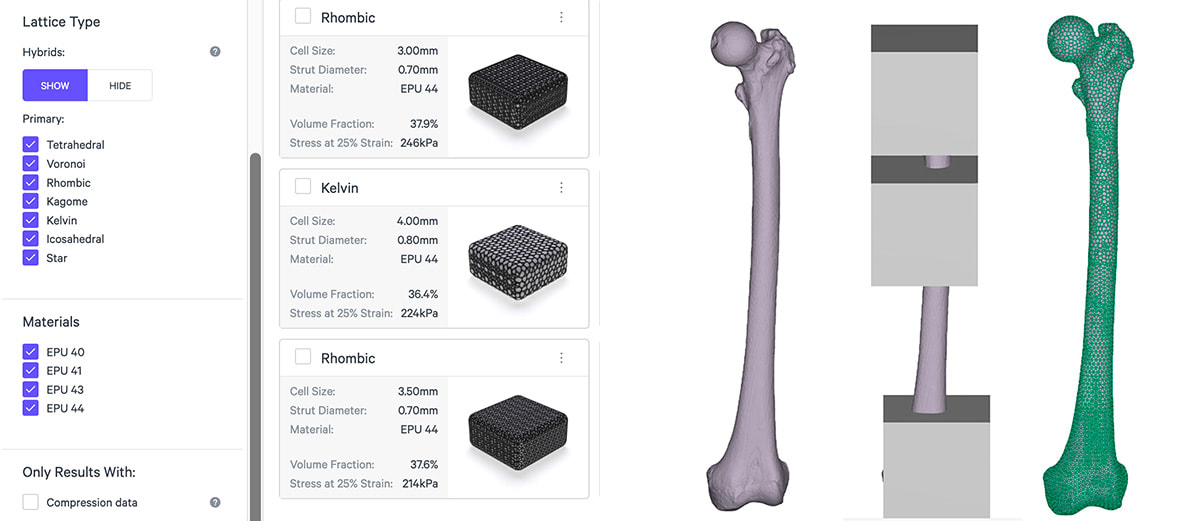
Coming Soon to Carbon’s Machine Learning Model
Carbon is always looking for opportunities to enhance our technology, so we are already hard at work improving our model. We’re adding more lattice types, including hex-based unit cells and hybrid cells. We’re adding more characterizations, like dynamic loading, and we want to make this capability available for more elastomer materials because Carbon’s library of materials is continually growing.
We’re also working on building better and more intuitive tools for designers. One such tool is Wilson GPT, a ChatBot similar to Chat GPT, which is using large language models (LLM) to interact with Lattice Search. Using the data generated from our ML model, a designer can ask Wilson GPT to find a resin or metamaterial that meets a list of specifications. Wilson GPT only references Carbon’s provided data to ensure the requester gets an accurate answer. As we expand our ML model, we expand the data available for Wilson GPT.
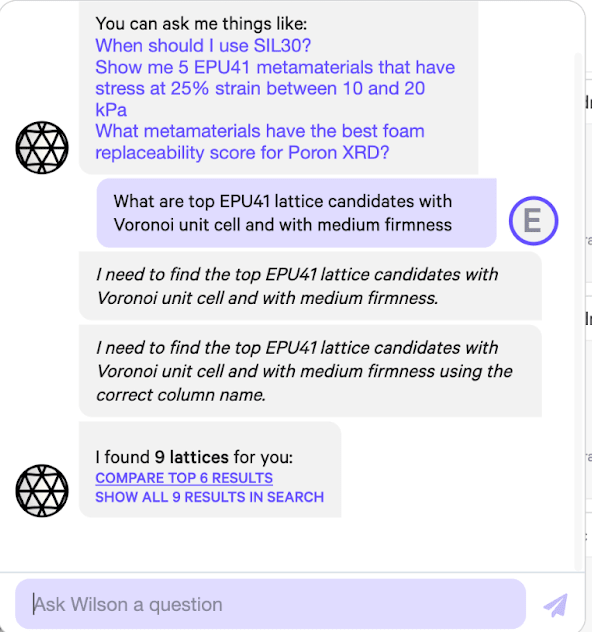
3D as It’s Meant to Be
Interested in utilizing Carbon to accelerate product development? Reach out to us at sales@carbon3d.com to learn more!
